15 Ways to Build Strong Reading Habits for Kids
Only 42% of American fourth graders read at or above proficiency level. Let that sink in. That’s less than half of our kids building the skill that impacts everything from vocabulary to critical thinking.
What if you could turn your reluctant reader into a bookworm who actually asks for “just one more chapter” at bedtime? Building strong reading habits for kids doesn’t require fancy programs or expensive tutors.
I’ve spent 15 years watching children transform from struggling readers into confident book lovers using these simple, consistent approaches. Each strategy is designed to make reading feel less like homework and more like an adventure they can’t wait to continue.
But there’s one technique most parents completely overlook that can double your child’s reading engagement in just seven days…
Create a Reading-Friendly Environment at Home
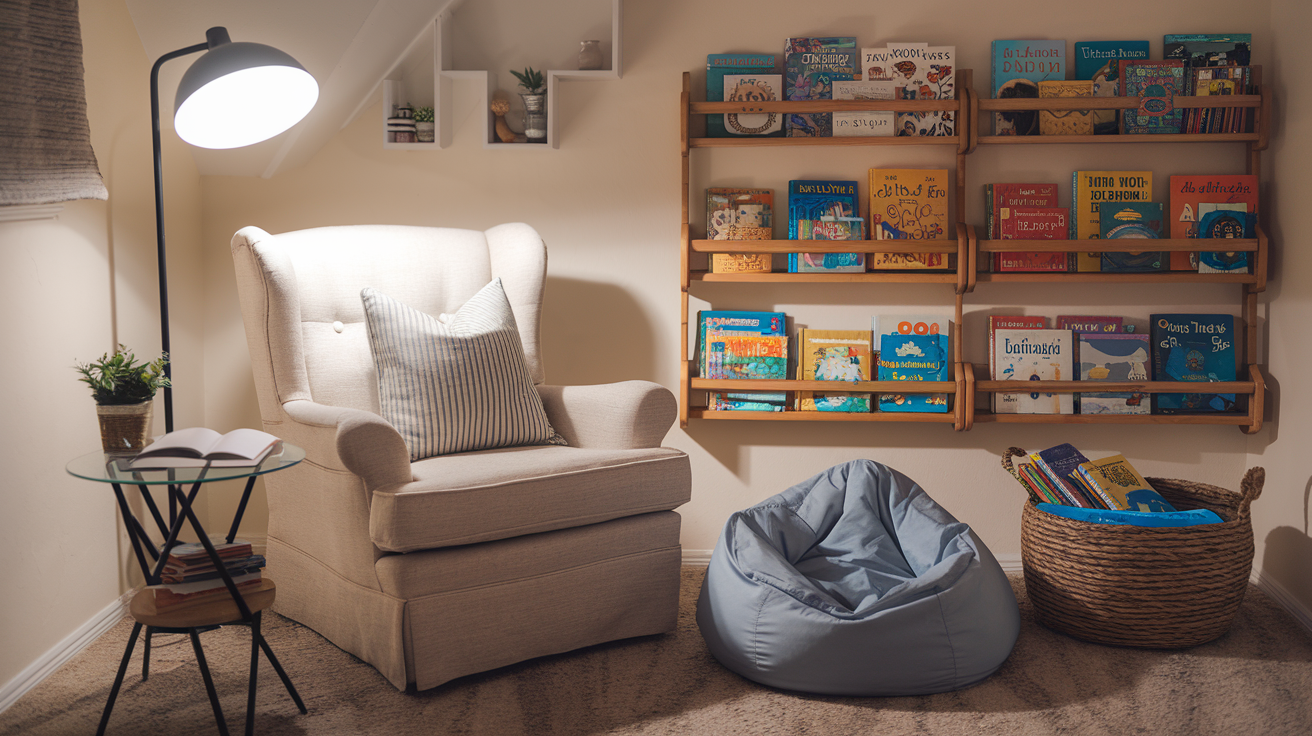
A. Design an inviting reading corner with comfortable seating
Kids are drawn to cozy spaces that feel special. A reading corner doesn’t need to be fancy – just comfortable and inviting. Grab some plush pillows, a soft rug, and maybe a bean bag chair. The key is creating a spot where your child feels snug and secure while diving into books.
Try adding a canopy or tent for that magical hideaway feel. Kids love little nooks they can call their own! Good lighting matters too – position the corner near natural light during the day, and add a warm lamp for evening reading sessions.
B. Build an accessible home library with age-appropriate books
Your home library doesn’t need to rival the public one – it just needs to be accessible to little hands. Low shelves or baskets on the floor work perfectly for toddlers and younger kids. For older children, organize books by topics they love – dinosaurs, space, princesses, whatever gets them excited!
Refresh your collection regularly. Swap books with friends, hit up garage sales, or make regular library trips. The magic happens when there’s always something new to discover.
C. Limit screen time to make room for reading
Let’s not sugarcoat it – screens and books are competing for your child’s attention. And screens often win because they’re designed to be addictive. Setting clear boundaries around screen time naturally creates space for reading.
Try using a visual timer so kids understand when screen time ends and reading time begins. Create a rhythm to your day – maybe screens go off an hour before bedtime, making space for stories before sleep.
D. Display books with covers facing outward to spark interest
Bookstore displays are designed to catch your eye – and your home can work the same way! Instead of showing just the spines, display some books with covers facing outward. Those colorful, enticing covers are meant to grab attention.
Rotate the featured books weekly. This simple switch makes your existing collection feel fresh and exciting. Watch how often your kids reach for the books on display!
E. Incorporate reading materials throughout your home
Reading doesn’t just happen in one special corner. Scatter interesting reading materials everywhere your family spends time. Keep cookbooks in the kitchen, magazines in the bathroom, puzzles books by the dinner table, and comics in the car.
When books become part of your home’s landscape rather than something special we “have to do,” kids absorb the message that reading is just part of everyday life. They’ll start picking up materials naturally during those in-between moments.
Remember that reading materials don’t have to be traditional books. Comic books, magazines about their interests, or even appropriate graphic novels all count as reading. The goal is engagement with text in whatever form excites them.
Lead by Example as a Reading Role Model

Let your children see you reading regularly
Kids are natural mimics. They’re watching everything you do, even when you think they aren’t paying attention. Want them to fall in love with reading? Show them you love it too.
Carve out 20 minutes daily where your whole family reads. Could be after dinner or before bed. Maybe you’re diving into a thriller while your child explores a picture book. The content doesn’t matter—showing that reading is part of adult life does.
And don’t just read silently! Let them catch you laughing at a funny passage or staying up late because “I just need to finish this chapter!” That genuine enthusiasm is contagious.
Share interesting facts or stories from your own reading
“Guess what I just learned?” might become your family’s favorite conversation starter. When you discover something fascinating in your book or magazine, share it at dinner.
“Did you know octopuses have three hearts?” or “I just read about a kid who started his own business at age 10!” These little knowledge bombs make reading feel valuable and exciting.
This works even with novels. Tell them about the wild adventure the main character just had or how a story reminded you of something in your own life.
Talk about books you enjoyed as a child
Your childhood favorites hold special magic. When you share stories about hiding under covers with a flashlight to finish “just one more chapter” or how a particular book helped you through a tough time, you’re building a bridge between generations.
Pull out your dog-eared copies of books you treasured growing up. The worn pages tell their own story about how much these books meant to you.
“This was my absolute favorite when I was exactly your age” creates an irresistible invitation for your child to discover what captivated you.
Visit libraries and bookstores together as family outings
Transform book-hunting into an adventure! Weekend trips to the library or bookstore should feel like treasure hunts, not chores.
Let everyone choose their own books without judgment. Maybe your kid wants comics or books about bugs while you browse mysteries. Perfect! The goal is associating books with pleasure, not forcing “educational” choices.
Many libraries and bookstores host story times, author visits, and other events. Make these special occasions. Grab ice cream after checking out new books or make it part of a fun Saturday routine.
Libraries especially are magical places for kids – free access to thousands of possibilities and librarians who love helping young readers find their next favorite story.
Establish Consistent Reading Routines
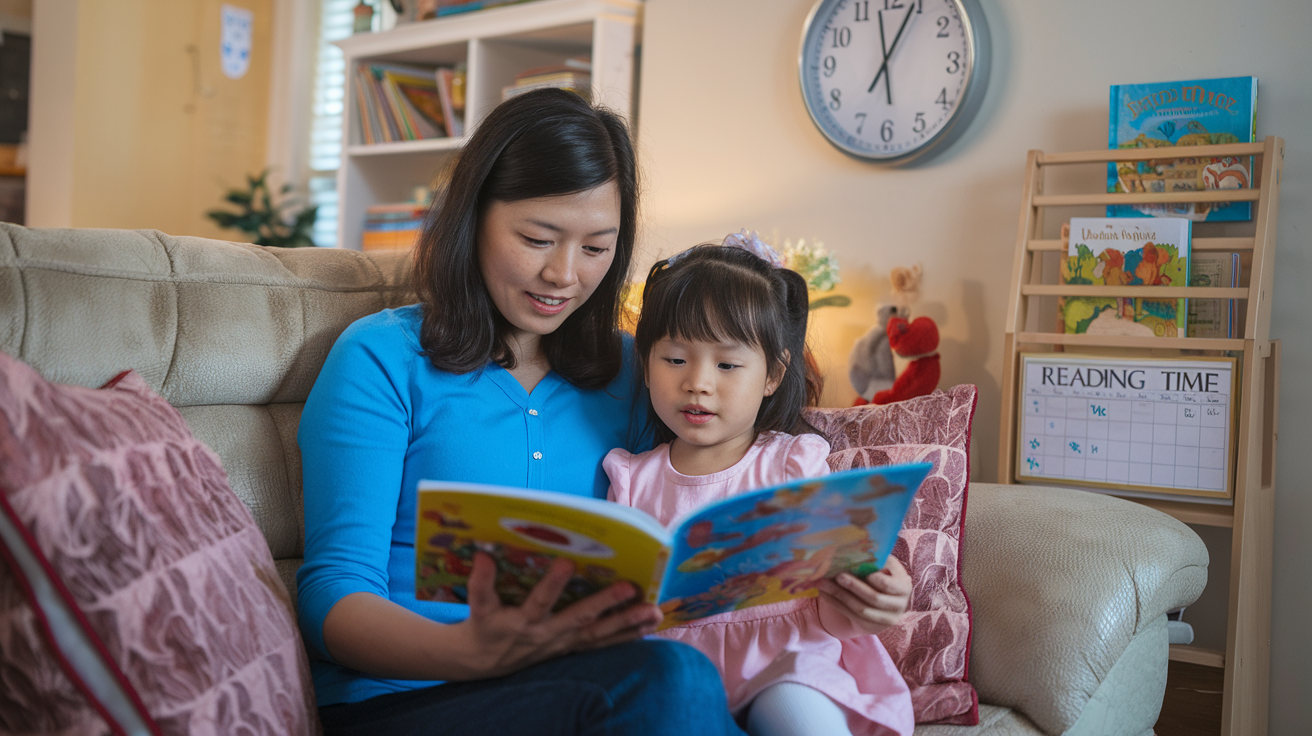
Set up a bedtime reading ritual
Kids thrive on predictability. When you make reading part of the nightly wind-down, it becomes as natural as brushing teeth. Start with just 10-15 minutes – consistency matters more than length.
Choose a cozy spot that’s reserved for bedtime stories. Maybe it’s a special chair in their room or a pillow fort you build together. The physical space signals to their brain: it’s story time.
“My daughter used to fight bedtime until we started our reading ritual,” says Melissa, mom of a 6-year-old. “Now she reminds ME it’s book time.”
Pro tip: Let kids pick the book sometimes. Even if you’ve read “The Very Hungry Caterpillar” fifty times, their excitement about choosing creates ownership in the routine.
Create weekend reading hours for the whole family
Weekends offer the perfect opportunity to show kids that reading isn’t just something we make them do – it’s something we all enjoy.
Try a “Saturday morning read-in” where everyone grabs their books and piles onto the couch or living room floor. Even 30 minutes makes an impression. The key? Parents need to actually read too, not scroll through phones.
Make it special with:
- Comfy pillows and blankets
- Light snacks that won’t damage books
- A timer so no one needs to watch the clock
Designate “no-tech” times dedicated to reading
In a world where screens constantly compete for attention, deliberately unplugging creates space for books to work their magic.
Try establishing a daily “no-tech hour” when all devices go into a basket. This works especially well after school or before dinner when kids need a mental reset. The first few days might bring complaints, but having interesting books readily available turns the tide quickly.
Post a visual reminder about tech-free times so it becomes a household rule rather than a battle of wills.
Build reading moments into daily transitions
The secret to fitting in more reading? Tucking it into the in-between spaces of your day.
Keep books:
- In the car for waits at soccer practice
- By the breakfast table for morning reading
- In a basket near the bathroom for siblings waiting their turn
- In a tote bag for doctor’s appointments or restaurant waits
These transition moments are golden opportunities. They’re short enough not to feel overwhelming but add up significantly over time.
Many parents find that having their child read instructions while cooking or grocery lists while shopping naturally incorporates reading into everyday tasks.
Make Reading a Social Experience
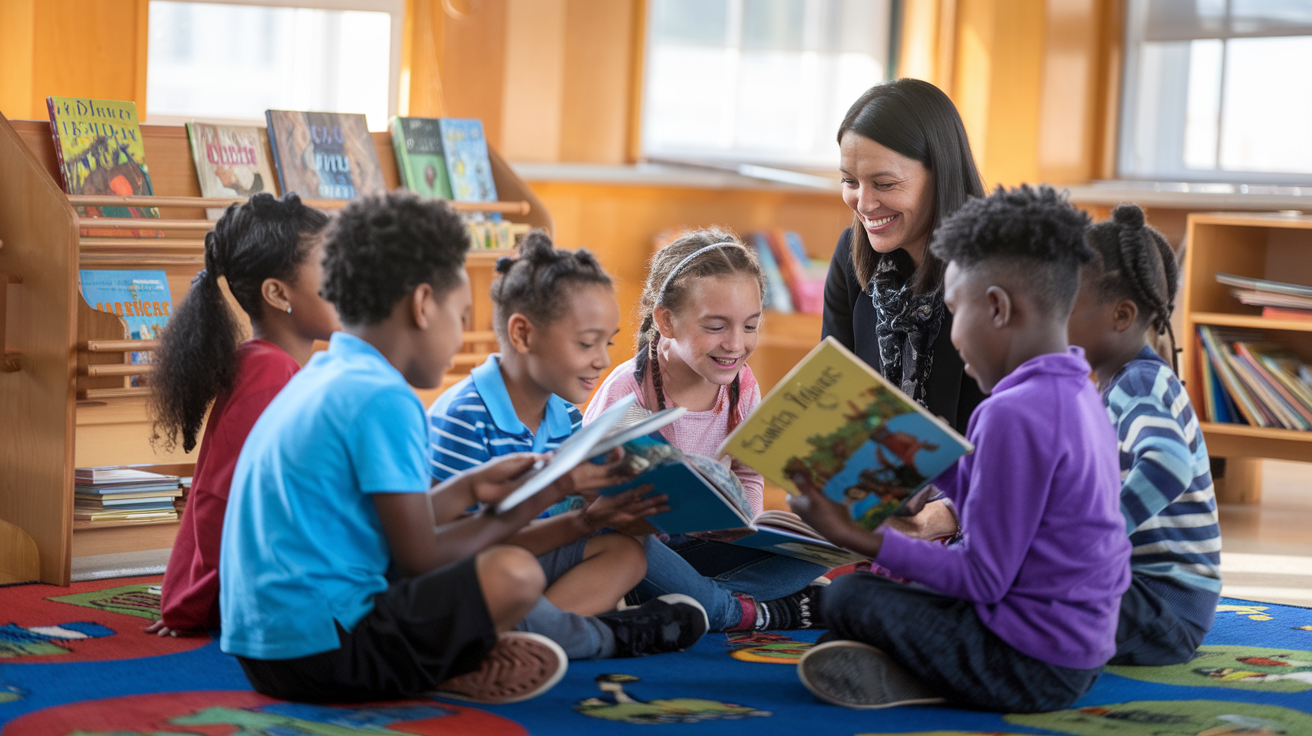
A. Start a family book club with regular discussions
Reading doesn’t have to be a solo activity! Creating a family book club transforms reading into something you all share. Pick age-appropriate books everyone can enjoy, then set a regular time to chat about them – maybe Sunday afternoons with some cookies and hot chocolate.
Ask open questions like “Which character would you want as a friend?” or “What would you have done differently?” rather than testing comprehension. Even your five-year-old will have opinions! When kids see you genuinely interested in their thoughts, they’ll be more excited about the next book.
B. Read aloud to children even after they can read independently
Many parents stop reading to kids once they can read on their own. Big mistake! Reading aloud to older children builds listening skills, introduces more complex stories, and creates magical moments that kids remember forever.
Your voice brings characters to life in ways the words alone can’t. Plus, you’re modeling proper pronunciation, rhythm, and expression. Kids who hear fluent reading become fluent readers themselves.
Try reading slightly above their independent level – they’ll understand more than you think when they hear it.
C. Take turns reading chapters in longer books
Tag-team reading is perfect for longer books that might otherwise intimidate young readers. You read a chapter, they read a chapter. This approach:
- Builds reading stamina without exhaustion
- Creates natural stopping points for discussion
- Makes challenging books more approachable
- Gives you both something to look forward to
My daughter and I read the entire Harry Potter series this way. On nights when she was tired, I’d read more. When she was excited about a section, she’d beg to read extra chapters.
D. Connect with other families for reading playdates
Reading playdates are genius! Invite neighborhood kids over for story time followed by activities related to the book. Read “Charlotte’s Web”? Make spider crafts after. “Magic Tree House”? Create time machines from cardboard boxes.
These gatherings show kids that reading is social currency – something to share and discuss with friends. The excitement of seeing their friends enjoy the same stories is contagious.
E. Participate in community reading events
Your local library isn’t just for borrowing books – it’s a social hub! Summer reading programs, author visits, and story hours connect your family with other book-loving families.
Bookstores often host readings too, sometimes with fun activities or even character appearances. These events make reading feel like a celebration rather than an assignment.
When kids see reading celebrated community-wide, they understand its value beyond school requirements. They’ll start to identify as readers – part of a special club of people who love stories.
Connect Reading to Children’s Interests

Find books related to their hobbies and passions
Want to know the secret to getting kids hooked on reading? It’s actually pretty simple – connect books to what they already love!
When my nephew showed zero interest in reading, I noticed how obsessed he was with dinosaurs. The next day, I brought him an illustrated encyclopedia of prehistoric creatures. He didn’t put it down for hours!
Kids are naturally drawn to topics they’re already passionate about. Does your child love soccer? Get them biographies of famous players or stories set in the world of sports. Are they into space? Find books about astronauts, planets, or sci-fi adventures among the stars.
The magic happens when children stop seeing reading as a chore and start seeing it as a gateway to more of what they already enjoy. Their motivation skyrockets when there’s personal connection to the material.
Explore different genres to discover what excites them
Not sure what kinds of books might click with your child? Time for some literary exploration!
Think of genres like different flavors of ice cream – your kid might not know they love mint chocolate chip until they try it. The same goes for mystery novels, fantasy adventures, historical fiction, or science books.
I’ve seen quiet, shy kids suddenly light up when discovering graphic novels. Others might unexpectedly fall in love with poetry or adventure stories.
Create a “genre sampling” game. Each week, pick up something completely different from your last read. Keep track of their reactions – which ones had them begging for “just one more chapter”?
Follow book series that keep them engaged
There’s something magical about book series that keeps kids coming back for more. It’s like the reading equivalent of binge-watching a great TV show!
Series books build reading momentum. Once a child connects with characters in the first book, they’re invested in following their journey through subsequent volumes. They develop relationships with these fictional friends and genuinely care what happens next.
Popular series like Harry Potter, Percy Jackson, or Diary of a Wimpy Kid have turned countless reluctant readers into bookworms. The familiar characters and continuous storylines create a comfortable reading experience where kids know what to expect but still get fresh adventures.
Mix fiction and non-fiction based on their curiosity
Children are naturally curious creatures, and smart parents use this to their advantage when building reading habits.
If your daughter is fascinated by how things work, alternate storybooks with illustrated non-fiction about machines, the human body, or natural phenomena. If your son asks endless questions about animals, mix up fun animal stories with fact-based nature books.
This balanced approach accomplishes two important things: it satisfies their hunger for knowledge while also developing their imagination through stories. It also helps them understand that reading isn’t just one thing – it’s a diverse tool for both entertainment and learning.
Some children initially prefer non-fiction and feel stories are “babyish,” while others avoid informational texts. By offering both, you’re expanding their reading palate and showing them the full spectrum of what books can offer.
Use Technology Strategically to Encourage Reading

Explore quality e-books and digital reading platforms
In today’s digital world, kids are naturally drawn to screens. So why not leverage that interest to build reading habits? Digital libraries like Epic! and Libby offer thousands of children’s books that can be accessed anytime, anywhere.
Kids often find e-readers appealing because they can adjust font sizes, use built-in dictionaries, and carry hundreds of books in one lightweight device. My neighbor’s shy 8-year-old actually reads more now because no one can see what book she’s reading on her Kindle!
For younger children, platforms like Storyline Online feature celebrities reading picture books aloud with animated illustrations that keep little ones engaged while building comprehension skills.
Try audiobooks for car rides and quiet time
Audiobooks count as reading too! They’re perfect for kids who might be reluctant readers or those who get carsick reading physical books during travel.
Services like Audible and Librivox have extensive children’s collections narrated by talented voice actors who bring stories to life. My son started with Harry Potter audiobooks during our commute and now begs for “story time” in the car.
Audiobooks also help children hear proper pronunciation, expression, and pacing – all critical components of reading fluency. Plus, they’re great for bedtime when eyes are tired but minds are still active.
Use reading apps that track progress and provide rewards
Kids love seeing their accomplishments, and reading apps tap into this brilliantly. Apps like ReadingIQ and Epic! track minutes read, books completed, and streaks maintained.
Most apps use gamification elements – badges, points, and virtual prizes – that turn reading into an exciting challenge rather than a chore. When my daughter earned her “50 Books Badge” on her reading app, she proudly showed everyone who visited our home that week!
Some schools use classroom platforms like Raz-Kids that let teachers assign books at appropriate reading levels while kids earn stars and points for completed readings and comprehension quizzes.
Find author websites with interactive content
Many children’s authors maintain websites packed with games, activities, and exclusive content related to their books. These sites create deeper connections between readers and stories.
Rick Riordan’s website offers mythology quizzes for Percy Jackson fans, while J.K. Rowling’s Wizarding World lets kids discover their Hogwarts house. These interactive experiences make the reading experience extend beyond the pages.
Author websites often announce upcoming books, share character backstories, or provide printable activities that turn passive reading into active engagement with the story world.
Celebrate Reading Achievements

Create reading challenges with meaningful rewards
Kids thrive on challenges, especially when there’s something awesome waiting at the finish line. Set up a summer reading challenge where your child earns a special outing after completing 10 books. Or maybe they get to choose dinner after finishing a chapter book on their own.
The key? Make the rewards meaningful, not just materialistic. Think movie nights, extra playground time, or choosing the family weekend activity. One dad I know lets his daughter stay up 15 minutes later for every book she finishes in a week – talk about motivation!
Don’t overthink this. Simple rewards work wonders:
- A special bookmark for completing their first chapter book
- A trip to the bookstore to pick out a new book after finishing five
- A reading-themed celebration with their favorite snacks
Track books read on a visible chart or journal
Nothing beats the satisfaction of seeing progress right before your eyes. Hang a colorful reading tracker on the fridge or in your child’s bedroom where they can add stickers, color in spaces, or draw pictures for each book they finish.
My nephew has a “reading tree” on his wall – each leaf represents a book he’s read. By the end of the year, his tree is bursting with leaves of achievement!
Digital options work great too. Many kids love using reading apps that show their progress with badges and virtual trophies. But there’s something special about physical trackers that kids can touch and show off.
Try these tracking ideas:
- A paper chain where each link represents a book
- A reading passport with “stamps” from different book genres
- A jar that fills with pom-poms or marbles for pages read
Recognize milestones with special privileges
When your child hits significant reading milestones, make it count! Finishing their first 100 books? That deserves something beyond the ordinary reward.
Special privileges carry weight with kids. After my friend’s daughter read 50 books, she earned the right to redecorate her reading nook. The pride on her face was priceless!
Some milestone privileges kids absolutely love:
- Staying up 30 minutes past bedtime for a special reading night
- Having breakfast for dinner
- Taking over the TV remote for an evening
- A “yes day” where you say yes to reasonable requests
Share accomplishments with extended family members
Kids beam with pride when their achievements get recognized beyond mom and dad. Set up video calls with grandparents where your child can share about their favorite recent books. Ask relatives to send congratulatory messages when your kid hits reading milestones.
My sister’s kids make quick book review videos to share with family. Their grandparents’ enthusiastic responses keep them racing through books just to make more videos!
Extended family can participate in your child’s reading journey even from afar:
- Relatives can mail books with personal notes inside
- Distant cousins can become reading pen pals
- Aunts and uncles can issue special reading challenges
- Grandparents can request “book reports” during their regular calls
Connect Books to Real-Life Experiences
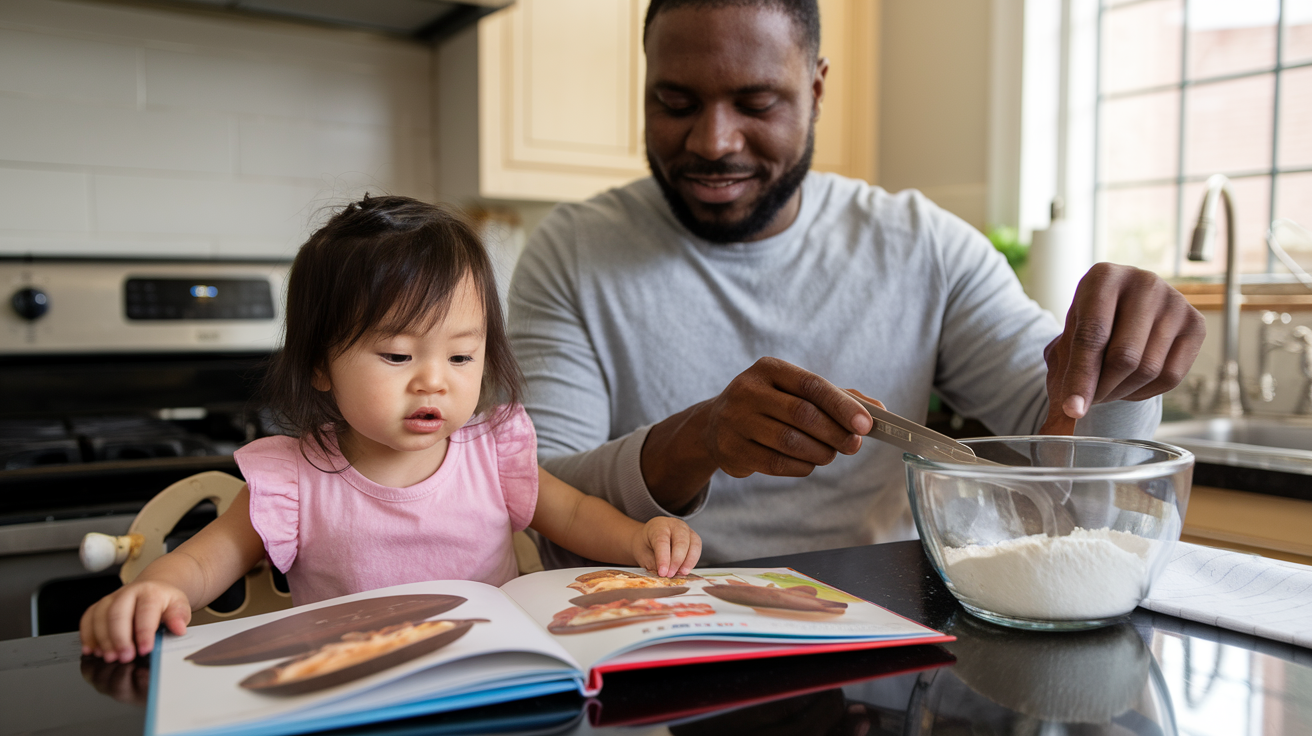
Visit places mentioned in favorite books
Books come to life when kids can actually touch, see, and smell the settings from their stories. Have a child who’s obsessed with “Madeline”? Plan a trip to Paris (or even just look up images online). Reading about ocean adventures? Head to the nearest aquarium.
My neighbor’s daughter was completely transformed after visiting a lighthouse similar to the one in her favorite picture book. Suddenly, the words weren’t just words anymore—they were memories she could connect to real experiences.
You don’t need expensive trips either. If your kid is reading about farms, a visit to a local petting zoo works wonders. City parks can become enchanted forests from fairy tales with a little imagination.
Cook recipes featured in stories
Nothing connects a story to real life quite like taste and smell. Remember the description of Turkish Delight in “The Lion, The Witch and The Wardrobe”? Make it together!
Kids who help prepare Hagrid’s rock cakes or green eggs and ham suddenly have skin in the game. They’re not just passive readers—they’re participants in the story.
My son never cared much for “Little House on the Prairie” until we made homemade butter together. Now he can’t get enough of pioneer stories.
Watch movie adaptations after reading the books
Movie night gets an educational upgrade when you watch film versions of books you’ve read together. The conversations that happen during these viewings are pure gold:
“That’s not how I imagined Willy Wonka!”
“They left out my favorite part!”
“I think the book explained that better.”
These comparisons develop critical thinking skills without kids even realizing they’re learning. Plus, it rewards reading with a fun activity.
Recreate scenes through art or dramatic play
Give kids clay, paper, cardboard boxes—whatever you have—and watch them build Hogwarts or draw Max’s wild rumpus. Role-playing favorite scenes takes comprehension to another level.
My daughter and her friends spent an entire weekend turning our basement into Narnia after reading “The Lion, The Witch and The Wardrobe.” They assigned characters, made props from household items, and acted out their favorite scenes.
This kind of play doesn’t just reinforce the story—it helps kids process the emotions and moral dilemmas characters face in a safe, controlled environment.
Develop Active Reading Skills

Ask open-ended questions during and after reading
Reading isn’t just about flipping pages – it’s about truly engaging with the story! One of the best ways to transform passive reading into an active experience is by asking your child open-ended questions. Instead of “Did you like the book?” (which gets you a simple yes or no), try “What was your favorite part and why?” This simple shift invites your child to think critically and express their thoughts more fully.
Some great starter questions include:
- “What do you think the main character learned by the end?”
- “How would you have solved the problem in the story?”
- “Which character would you want to be friends with?”
Encourage predictions about what might happen next
Turn reading into a game of “what if” by pausing mid-story and asking your child to guess what comes next. This builds anticipation and keeps kids mentally engaged with the narrative. You might say, “The character just found a mysterious key. What do you think it opens?” or “The storm is getting worse – what do you think will happen to their camping trip?”
This prediction habit trains kids to pay attention to plot details and character development. Plus, it’s just plain fun to see if their guesses come true!
Discuss character motivations and feelings
Characters are the heart of any good story, and understanding why they do what they do builds emotional intelligence. When reading with your child, pause to discuss characters’ feelings:
“How do you think Max felt when he was sent to his room?”
“Why do you think Charlotte decided to help Wilbur?”
These conversations help kids recognize emotions in others and develop empathy. They’ll start to understand that people (and characters) have reasons behind their actions, even when those actions seem confusing at first.
Make connections between different books and stories
Kids’ brains light up when they spot patterns across different stories. Help them build these neural pathways by pointing out similarities: “Remember how this character has to solve a mystery like Harriet the Spy did?” or “This story has talking animals just like Charlotte’s Web!”
These connections help children develop a mental library of stories, themes, and character types. Soon they’ll start making these connections independently, saying things like “This reminds me of…” which shows they’re processing stories at a deeper level.
Practice retelling stories in their own words
Nothing shows understanding like being able to explain something to someone else. After finishing a book, ask your child to retell the story as if they were sharing it with someone who hasn’t read it.
This exercise strengthens memory, helps them identify the most important parts of a story, and builds confidence in their storytelling abilities. Start by having them retell simple picture books, then gradually work up to more complex stories.
You can make this fun by taking turns adding details to the retelling, or by using puppets or toys to act out the story together. Some kids even enjoy recording their retellings as “audiobooks” for younger siblings or relatives.
Expand Vocabulary Through Reading

Keep a family word wall of interesting new words
Words are the building blocks of language, and what better way to stack them up than with a family word wall? This colorful, ever-growing collection becomes your kid’s visual dictionary of discovery.
Start with a dedicated space—maybe that empty kitchen wall or the back of a door. Whenever your child stumbles across a juicy new word during reading time, write it on a colorful sticky note or index card along with a quick, kid-friendly definition.
“Magnificent” from that dragon book? Up it goes! “Camouflage” from the nature magazine? Add it to the wall!
The magic happens when these words become part of your family culture. Point to them during conversations. Challenge each other to use three word wall words at dinner. Watch your six-year-old’s face light up when she correctly uses “dilapidated” to describe her brother’s messy room.
Make it a living installation by rotating words every few weeks, moving older ones to a special “word graduate” box that kids can flip through when they need inspiration for writing or speaking.
Play word games based on recent readings
Game night just got a vocabulary boost! Transform those fresh-off-the-page words into playful learning opportunities.
Try “Word Wall Charades” where kids act out their favorite new words. Nothing beats watching your eight-year-old attempt to demonstrate “bewildered” with dramatic flair.
Or dive into “Bookworm Bingo” with cards featuring recent vocabulary. Read definitions aloud and have players mark matching words—instant comprehension check disguised as fun!
For car rides, play “I Spy a Story Word” where everyone takes turns spotting real-world examples of book vocabulary. “I spy something ‘enormous’… the construction crane!”
Create matching games with words and definitions for younger readers, or challenge older kids with “Word Jenga”—write words on Jenga pieces and players must use them in a sentence before pulling.
These games cement word meanings through context, repetition, and—most importantly—laughter.
Look up unfamiliar words together
The dictionary moment can be magical when shared. When your child bumps into an unknown word, resist the urge to simply define it for them.
Instead, make detective work part of the reading experience. Keep age-appropriate dictionaries within arm’s reach of reading spots. For younger kids, picture dictionaries work wonders. Older children might enjoy a “real” dictionary or a kid-friendly dictionary app on a tablet.
Model curiosity by looking up words yourself. “Hmm, ‘labyrinthine’—I’m not totally sure what that means. Let’s check it out together!”
Turn dictionary skills into a mini-adventure: “How fast can we find ‘perseverance’?” or “Can you find three synonyms for ‘happy’?”
The process sticks better than simply being told. When kids physically search for words, they encounter other interesting terms along the way and develop research skills that serve them throughout life.
Use new vocabulary in daily conversations
This is where word power truly develops—when vocabulary jumps off the page and into real life.
Challenge yourselves to a “Word of the Day” practice. Everyone tries to use the selected word naturally throughout the day. Even better when it’s a word from yesterday’s bedtime story.
Create vocabulary-rich environments by narrating everyday activities with precision. Instead of “Let’s clean up,” try “Let’s organize these scattered toys.” Small shifts make big differences in language exposure.
Praise kids when they attempt to use new words, even if imperfectly. “I love how you described the sunset as ‘magnificent’—that’s exactly right!”
Model language growth yourself. “I used to call this feeling ‘sad,’ but ‘melancholy’ describes it better because it’s a quiet kind of sadness.”
The dinner table becomes vocabulary central when you ask, “What interesting words did you read today?” Soon, kids won’t just be reading words—they’ll be collecting them like treasures to share.
Overcome Reading Challenges Together

Identify and address specific reading difficulties early
Reading struggles come in all shapes and sizes. Maybe your child reverses letters, reads slowly, or just seems to hate picking up books. The sooner you spot these hiccups, the faster you can help.
Pay attention to warning signs. Does your little one struggle with rhyming words? Forget what they just read? Avoid reading altogether? These aren’t just “phases” – they’re clues.
Talk to teachers. They see dozens of kids reading daily and can spot patterns you might miss. Don’t wait for parent-teacher conferences – shoot them a quick email asking specifically about reading progress.
Remember: early intervention isn’t about labeling your child. It’s about giving them tools before frustration sets in and they decide “reading isn’t for me.”
Try paired reading for struggling readers
This technique is pure magic for boosting confidence. Here’s how it works:
- Sit side-by-side with your child
- Read aloud together at the same pace
- When they feel confident, they give a signal (like a tap on your arm)
- You stop reading, they continue solo
- If they stumble, you jump back in together
The beauty? No pressure. When reading gets tough, you’re right there reading along. When it’s flowing, they get to shine.
Break longer books into manageable sections
Big books can overwhelm even grown-ups sometimes! Try these approaches:
- Use bookmarks to create “reading checkpoints”
- Set mini-goals: “Let’s read to page 15 tonight”
- Celebrate each section completion with a small reward
- Talk about each chapter before moving to the next
This approach teaches kids that tackling big challenges bit by bit makes them doable. Plus, those little victories along the way? They’re confidence builders.
Find high-interest, accessible texts for reluctant readers
The secret weapon against reading resistance? Books that match both interest level AND reading level.
A dinosaur-obsessed kid who struggles with reading doesn’t need “baby books” – they need dinosaur books with simpler text. A sports-loving child might devour stats and player bios even if they reject fiction.
Don’t dismiss graphic novels, magazines, or even appropriate video game text. Reading is reading! When kids connect reading with their passions, the motivation comes naturally.
The best strategy? Hit the library together and let them choose. Their excitement when finding “their” book beats any reading assignment you could ever create.
Diversify Reading Materials
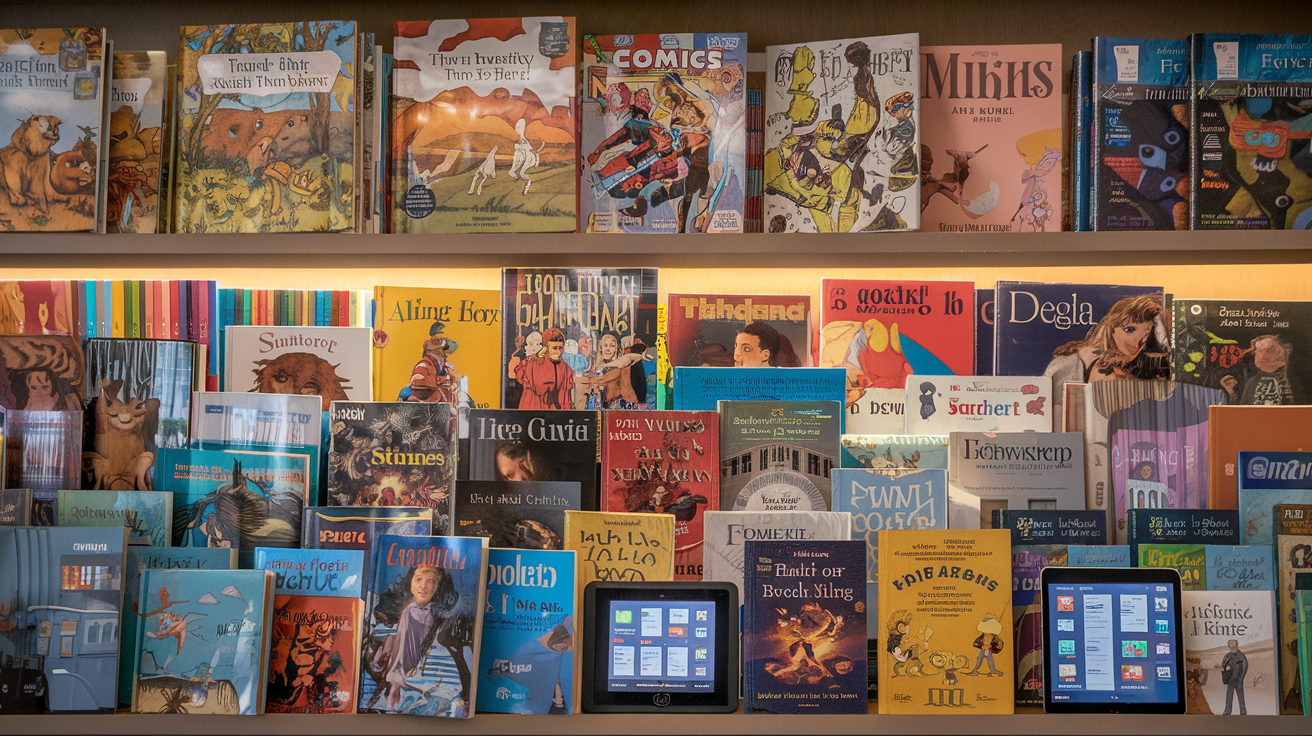
Explore magazines and newspapers for children
Tired of the same old bedtime stories? Shake things up with kids’ magazines and newspapers! These colorful publications offer bite-sized content that’s perfect for shorter attention spans. Publications like Highlights, National Geographic Kids, and Time for Kids deliver age-appropriate news, puzzles, and fascinating facts that keep young minds engaged.
What makes these especially powerful is their regular delivery schedule. A monthly magazine subscription creates anticipation and excitement around reading—”Mom, did my Ranger Rick come in the mail today?” That regular reading ritual builds habits naturally.
Benefits of periodicals:
- Fresh content monthly
- Diverse topics in one issue
- Real-world connections
- Interactive elements (puzzles, games)
- Collectible series they’ll want to complete
Incorporate comic books and graphic novels
Comics aren’t just fun—they’re literacy powerhouses! The combination of visual storytelling with text creates a perfect bridge for reluctant readers. When kids see characters’ expressions alongside dialogue, they naturally develop comprehension skills.
Graphic novels like “Dog Man,” “Smile,” or classic “Tintin” adventures offer complex storylines with the visual support some readers need. Studies show graphic novel readers develop stronger vocabulary and reading confidence than kids who stick to traditional texts alone.
Parents who worry comics aren’t “real reading” are missing out on a powerful tool. The reality? Kids who read comics typically read more overall and transition more easily to text-only books when ready.
Read poetry and rhyming books aloud
Poetry is reading’s secret weapon! Those catchy rhythms and playful sounds aren’t just entertaining—they’re building critical phonological awareness skills. When you read “The Lorax” or Shel Silverstein’s quirky poems aloud, your child’s brain is mapping sounds to letters automatically.
Poetry reading creates magical moments between you and your child. Take turns with poems from collections like “Where the Sidewalk Ends” or try modern favorites from authors like Kwame Alexander. The brevity of poems makes them perfect for squeezing reading into busy days.
Don’t worry about understanding every metaphor—just enjoy the language play together!
Try books in different formats (pop-up, interactive, etc.)
Books come in so many exciting forms beyond traditional hardcovers! For younger readers especially, tactile experiences with books create positive associations with reading.
Pop-up books transform reading into a 3D adventure. Interactive books with flaps, textures, or sound buttons make stories come alive. Digital interactive books add another dimension with animation and sound effects that can hook tech-savvy kids.
These format variations aren’t just novelties—they serve important developmental purposes:
- Touch-and-feel books develop sensory processing
- Lift-the-flap books teach cause and effect
- Pop-up books improve spatial awareness
- Sound books reinforce phonics connections
Include diverse characters and cultures in book selections
Today’s kids need windows and mirrors in their reading—books that reflect their own experiences and ones that show them different worlds. When children see themselves in stories, reading becomes personally meaningful. When they encounter different cultures and experiences, they develop empathy and broader worldviews.
Look for books featuring characters from various backgrounds, abilities, family structures, and traditions. Classics like “Amazing Grace” show determination across cultural lines, while newer titles like “Hair Love” celebrate specific cultural experiences beautifully.
Ask librarians for recommendations or check resources like WeNeedDiverseBooks.org. The key is making diversity a natural part of your reading rotation, not a special occasion. When kids see all kinds of heroes in their stories, they learn that everyone’s story matters—including their own.
Engage with Authors and Books Beyond Reading

Attend author events and book signings
Reading comes alive when kids meet the actual humans behind their favorite stories! Author events create those magical moments where characters and creators connect. Next time you spot a flyer for an author visit at your local bookstore or library, mark that calendar!
My friend’s daughter met her favorite picture book author last summer and wouldn’t stop talking about it for weeks. That 10-minute interaction did more for her reading motivation than months of reminders.
These events often include:
- Interactive readings where authors bring their own words to life
- Behind-the-scenes stories about how books are made
- Q&A sessions where kids can ask burning questions
- Book signings that turn ordinary books into treasured keepsakes
Write letters to favorite authors
Kids light up when they realize authors are real people who might actually write back! Many authors love receiving fan mail and some even respond personally.
Help your child craft a letter sharing:
- Their favorite part of the book
- Questions about characters or story decisions
- Ideas for sequels or new adventures
- How the book made them feel
This simple activity teaches communication skills while deepening their connection to stories they love.
Create book-inspired art or writing projects
Books spark imagination that begs to be expressed! Turn reading into a springboard for creativity by:
- Designing alternative book covers
- Crafting dioramas of favorite scenes
- Writing “missing chapters” or sequel stories
- Making character puppets for story reenactments
- Creating recipe books based on food mentioned in stories
My nephew spent an entire weekend building a cardboard Hogwarts after finishing the first Harry Potter book – his enthusiasm for reading doubled afterward!
Follow book-related social media accounts together
The book world buzzes online! Many authors, illustrators, and publishers share fascinating behind-the-scenes content that gets kids excited about books in a whole new way.
Together with your child, follow accounts that:
- Preview upcoming releases
- Show illustrators’ drawing processes
- Share author reading recommendations
- Host virtual Q&As and book discussions
Just 5 minutes scrolling through an author’s Instagram can spark curiosity about their entire book catalog!
Leverage School and Community Resources

Build relationships with school librarians and teachers
Your child’s school is a goldmine of reading resources that often go untapped. The librarians and teachers are literacy champions who know exactly which books might ignite your child’s imagination.
Next time you’re at school, introduce yourself to the librarian. These book experts can recommend titles that match your kid’s interests and reading level. They notice which books are flying off the shelves with other children your kid’s age.
Teachers observe your child’s reading habits daily. During parent-teacher conferences, ask specific questions like:
- “Which books has my child shown interest in?”
- “Are there particular genres that might help them engage more?”
- “What reading strategies are you using that I could reinforce at home?”
Many educators maintain classroom libraries with books they personally love. When a teacher recommends a book with enthusiasm, kids pick up on that excitement.
Participate in library summer reading programs
Summer slide is real – kids can lose up to two months of reading skills during vacation. But summer reading programs are the perfect antidote.
These programs typically offer:
- Reading logs to track progress
- Fun prizes and incentives
- Weekly themed activities
- Author visits and special events
The structure keeps kids accountable while the rewards make reading feel like a game rather than homework. Plus, the community aspect creates a shared experience with other book-loving families.
My neighbor’s reluctant reader transformed into a bookworm after one summer program. The superhero theme hooked him, and the treasure box prizes kept him coming back until reading itself became the reward.
Join or start a neighborhood book exchange
Nothing refreshes a stale home library like a neighborhood book swap. Kids get excited about “new” books without spending a dime.
Starting a book exchange is simpler than you might think:
- Set up a weatherproof container on your porch or in a community space
- Stock it with books your family has outgrown
- Add a simple sign: “Take a book, leave a book”
- Spread the word through neighborhood social media
For a more organized approach, host quarterly book swap parties where kids can trade directly and discuss their favorites. My daughter discovered her now-favorite series through a neighbor’s recommendation during our block’s spring swap.
Volunteer for literacy programs as a family
When kids see you prioritizing reading for others, they internalize its importance. Family volunteering combines service learning with literacy promotion.
Consider these opportunities:
- Reading to seniors at retirement communities
- Helping with story time at preschools
- Sorting book donations at literacy organizations
- Recording audiobooks for visually impaired listeners
The commitment doesn’t need to be enormous. Even monthly volunteering makes an impact – both on those you’re helping and on your child’s reading identity.
My son started as a reluctant reader but transformed after volunteering with Reading Buddies. Teaching younger kids made him feel competent and responsible. The confidence spilled over into his own reading journey.
Adapt Reading Habits as Children Grow

Gradually increase reading complexity and duration
Kids grow up fast – and their reading abilities grow right along with them. When your little one masters picture books with simple sentences, it’s time to level up. Try books with slightly longer paragraphs, more complex plots, and a few challenging words sprinkled in.
Start by extending reading time in small increments. If you’ve been reading for 10 minutes, try 15. Then 20. Your child’s attention span is strengthening just like a muscle.
Don’t rush this process! Some kids need more time with certain types of books before they’re ready to tackle more complex ones. That’s completely normal.
Support transition to independent reading while maintaining shared reading time
Remember when your child first learned to ride a bike? Independent reading works the same way. They need practice with you holding the back of the seat before they can pedal off alone.
Try the “I read, you read” approach where you take turns reading pages. Or let them read simpler books independently while saving more complex stories for reading together.
Even as kids become stronger readers, don’t abandon shared reading time! Teens still benefit enormously from hearing complex material read aloud. Plus, reading together creates connection moments that get harder to find as kids grow older.
Discuss more complex themes and ideas as appropriate
As your child matures, books open doors to discussing real-world topics. When Harry Potter faces loss, it creates space to talk about grief. When characters encounter injustice, you can explore fairness and standing up for what’s right.
Ask open-ended questions like:
- “Why do you think the character made that choice?”
- “How would you have handled that situation?”
- “What surprised you most about this story?”
These conversations help kids develop critical thinking skills while processing complex emotions in a safe space.
Allow increasing autonomy in book selection while providing guidance
Kids who choose their own books are more motivated to read them. As they grow, gradually release the reins of book selection. Let them browse library shelves and follow their curiosities.
That said, guidance still matters. If your child gravitates exclusively toward one type of book (looking at you, graphic novels), gently suggest branching out. Try: “Since you loved that Dogman book, you might enjoy this adventure novel that also has a brave main character.”
Create a balanced approach: maybe they choose three books independently, and you suggest one. This builds decision-making skills while ensuring they encounter diverse reading material.

Building strong reading habits in children is a lifelong gift that extends far beyond academic success. By implementing these fifteen strategies—from creating reading-friendly spaces and modeling good reading behavior to connecting books with real-life experiences and celebrating reading milestones—parents and caregivers can nurture a genuine love of reading that will serve children throughout their lives. Remember that consistency, patience, and flexibility are key as you adapt these approaches to match your child’s evolving interests and developmental stages.
Your efforts to foster reading habits today will empower your children to become confident, curious learners tomorrow. Start with just a few of these strategies and gradually incorporate others as they fit naturally into your family routine. The journey to raising a reader is filled with wonderful discoveries, meaningful connections, and countless opportunities to grow together through the magic of books.
















